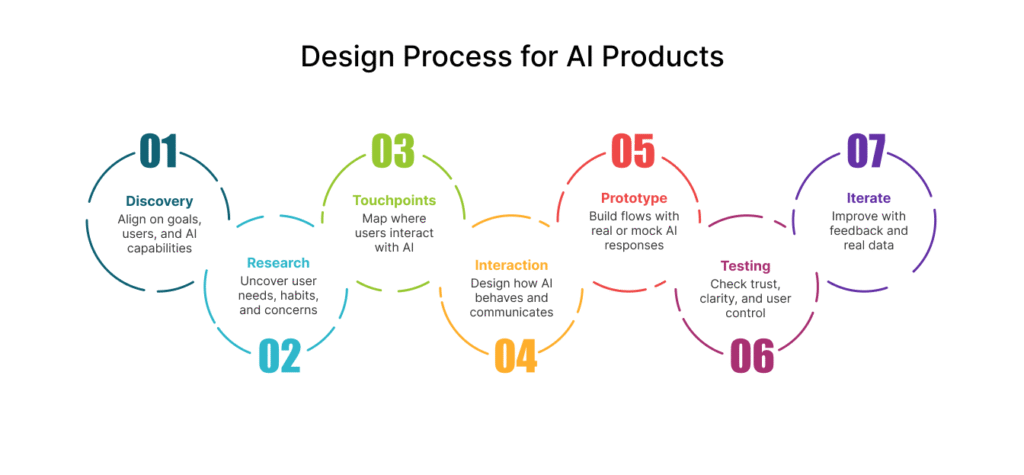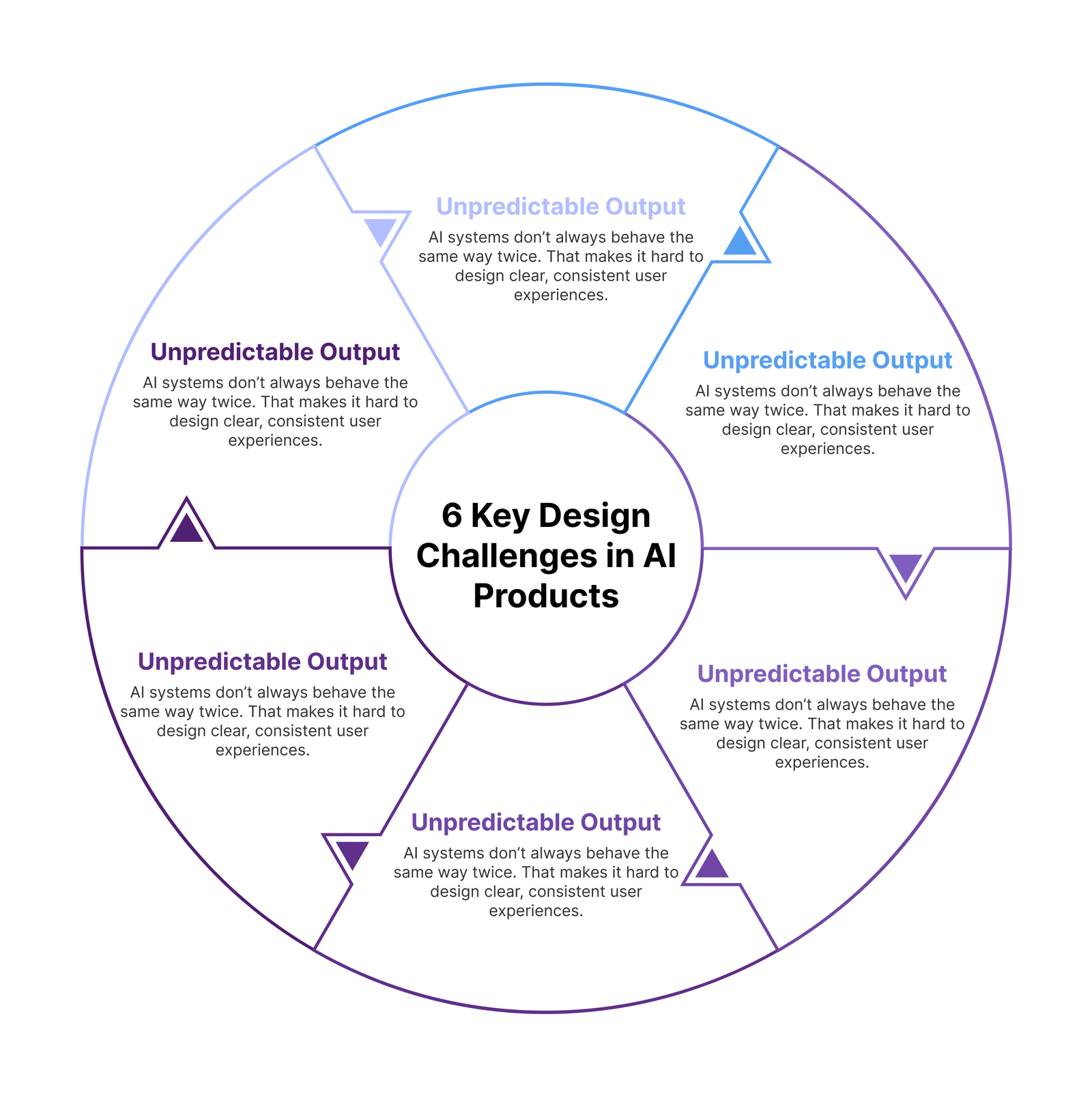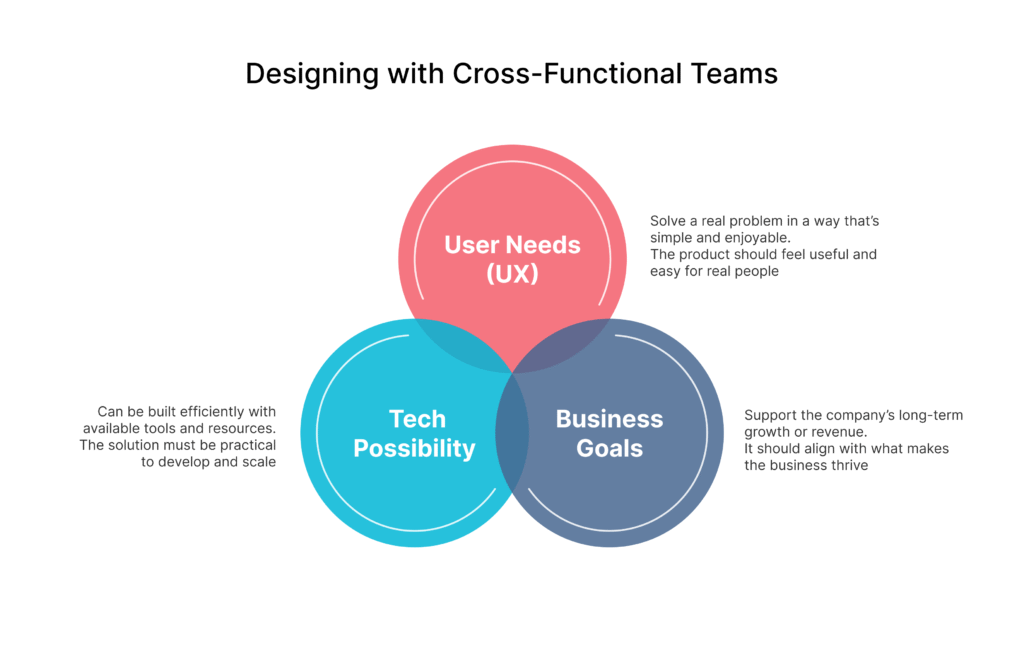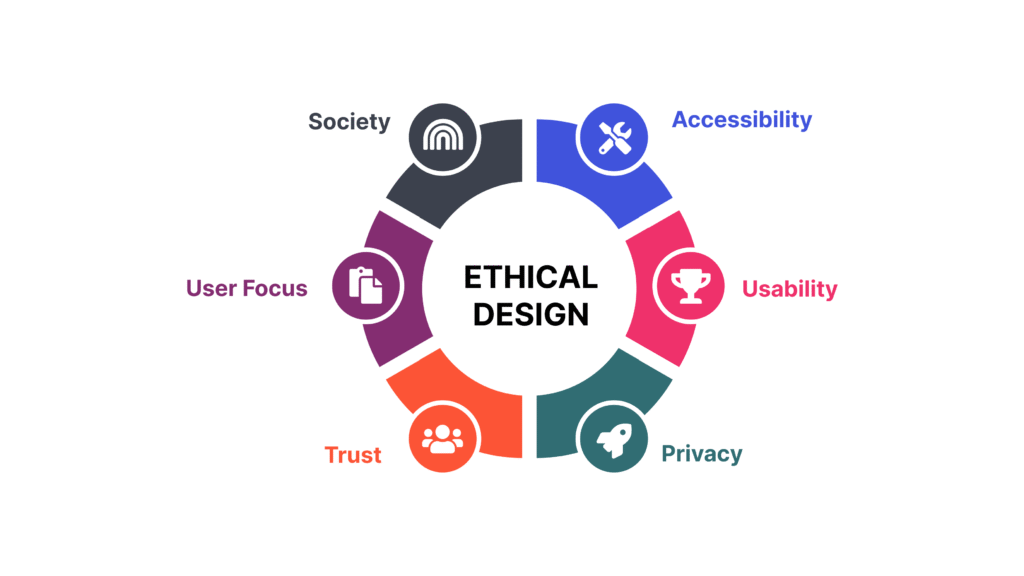Artificial design requires a fundamentally different approach to user experience than traditional products. A strong user experience (UX) has consistently been central to the success of any product development lifecycle, especially AI products that require careful designing processes.
When developing product design AI solutions, we must recognize that trust and transparency are crucial in AI-driven design. Unlike conventional software, AI for product design introduces unique challenges – from unpredictable behaviors to complex ethical considerations. For instance, effective error handling becomes critical for maintaining user trust when AI makes mistakes.
What makes artificial design intelligence particularly challenging is that AI-first products are built entirely on and around artificial intelligence. With AI-first design, artificial intelligence is absolutely integral to the product’s purpose and functionality, requiring founders to think differently about how users will interact with their systems.
Furthermore, we’ve found that the core need of UX design for AI is to create holistic interaction experiences by focusing on affordances and signifiers that build inclusive products for everyone – accessible and intuitive. Trust is a crucial factor for any user to adopt and stick around, making it essential that we address these considerations from the earliest stages of development.
What Makes AI-First Product Design Different?
“You’ve got to start with the customer experience and work backwards for the technology. You can’t start with the technology and try to figure out where you’re going to try to sell it.”
Steve Jobs, Co-founder and former CEO of Apple Inc., pioneer in user-centered product design
AI-first product design marks a fundamental shift in how we conceptualize and develop digital experiences. While traditional products might incorporate AI features as add-ons, AI-first products place artificial intelligence at their core, creating entirely new design challenges and opportunities.

Definition and examples of AI-first products
AI-first products are built entirely on and around artificial intelligence, with AI being absolutely integral to the product’s purpose and functionality. Essentially, if you removed the AI component, these products would cease to provide any value. Consider these examples:
- ChatGPT or Midjourney: Without AI, these platforms couldn’t understand questions or generate responses
- Amazon Alexa: Uses Natural Language Processing and machine learning to understand verbal instructions and continuously adapt to user preferences
- AI-powered recommendation systems: Personalize experiences based on user behavior and preferences
As opposed to simply enhancing existing products with AI capabilities, these solutions are conceived from the ground up with artificial intelligence as their foundation.
How AI-first differs from traditional UX?
Traditional UX design operates on the assumption that humans must learn to use machines through interfaces like menus, buttons, and navigation patterns. However, in AI-first design, this paradigm completely reverses: the machine must learn the user.
Additionally, traditional product design creates relatively static solutions with straightforward user journeys. In contrast, AI-first products adapt to each individual user in real-time, generating dynamic and personalized experiences. This adaptability makes user journeys significantly less predictable and more diverse.
Above all, AI-first product design is data-dependent rather than merely data-driven. These products require continuous data collection and analysis to learn and improve over time, making data integral to both the design process and the product itself.
Why founders need to think differently?
When developing AI-first products, founders must shift their thinking from “How can we improve our product with AI?” to “How can AI solve this specific user problem?”. This reframes the entire design process, requiring a problem-solving approach viewed through the lens of artificial intelligence.
Founders must also embrace a broader cross-functional collaboration. Beyond the typical team of designers and developers, AI-first products demand input from data scientists, AI-specialized researchers, and ideally dedicated ethicists to address bias, privacy concerns, and potential risks.
Primarily, founders need to maintain unwavering focus on solving real human problems despite the technological sophistication of AI systems. The fundamental goal remains creating genuine value for users, even as the technical complexity increases.
Key UX Challenges in AI Product Design
Designing exceptional AI systems presents unique obstacles that traditional product design approaches simply cannot address. Based on my experience with artificial design intelligence, three critical challenges stand out:

Handling unpredictable user journeys
Testing AI-driven interfaces proves exceptionally difficult since their behavior changes dynamically based on inputs. Unlike conventional products with predictable paths, AI systems create personalized experiences that vary with each user interaction. Consequently, AI for product design requires embracing uncertainty while still delivering intuitive experiences. This unpredictability makes it harder to identify and correct usability issues before deployment.
Dealing with bias and ethical concerns
AI systems mirror the data they’re trained on, often reflecting real-world biases. According to Gartner, 85% of AI projects fail to deliver on their promises, frequently due to overlooked biases in their training data. Companies prioritizing ethical artificial design can see up to a 20% increase in user trust and 15% rise in customer retention. Moreover, transparency becomes essential since many AI systems operate as “black boxes,” making decisions without explaining their reasoning, which erodes user confidence.
Maintaining performance as AI scales
Even successful machine learning models eventually degrade in performance due to changes in underlying data or evolving business requirements. As product design AI projects scale, data teams struggle with increasing complexity and inefficient collaboration processes. Accordingly, establishing clear rules and standardized workflows from the outset prevents models from becoming increasingly difficult to correct as they develop.
Designing with Data and Cross-Functional Teams
At the heart of effective artificial design lies a crucial relationship with data and team collaboration. The success of AI products depends on thoughtful integration between these elements.

Why AI design is data-dependent?
Artificial design intelligence fundamentally relies on data quality, volume, and variety. Without large amounts of high-quality data, AI systems cannot reason, learn, or make informed decisions. Product design AI requires continuous data collection and analysis to evolve over time. Data validation techniques like type checking, range constraints, and format validation ensure the integrity essential for AI systems to function properly.
Working with data scientists and engineers
Cross-functional collaboration has become increasingly vital in AI for product design. Previously, designers would define experiences first, subsequently briefing data scientists. Today, data scientists partner directly with designers throughout the entire product lifecycle. This partnership creates a powerful synergy—designers bring user perspectives while data scientists apply technical methods. Importantly, data scientists’ ability to analyze patterns in user behavior provides real-time insights that optimize user experiences.
Tools and workflows for AI product teams
Numerous tools assist artificial design teams in their collaborative efforts. Maze automates usability testing and helps test prototypes quickly, making user research more accessible. Similarly, Dovetail streamlines transcription and research summaries. First thing to remember is that AI isn’t replacing designers but reducing work that doesn’t add real value—allowing more time for strategic thinking.
Building Ethical and Inclusive AI Experiences
“When UX doesn’t consider ALL users, shouldn’t it be known as ‘SOME User Experience’ or… SUX?” — Billy Gregory, Accessibility advocate and director at The Paciello Group
Ethical considerations form the foundation of successful artificial design intelligence. Crafting AI experiences that work equitably for all users requires deliberate action beyond technical implementation.

Detecting and mitigating bias in AI
AI bias manifests as systematic errors leading to unfair outcomes that disproportionately affect marginalized groups. Consider AI recruiting tools that inadvertently favor certain demographics based on historical hiring patterns. Algorithms can perpetuate existing biases when trained on unrepresentative data, as exemplified by healthcare AI that performs poorly on patients with darker skin tones. Mitigating these issues demands diverse training datasets, strong governance frameworks, and continuous feedback loops.
Designing for accessibility and fairness
Inclusive artificial design extends functionality to people across ability spectrums. Throughout development, collaboration with the disability community remains vital for creating genuinely accessible solutions. Teams should identify accessibility considerations for AI copilots early and conduct thorough user testing to validate inclusivity. Noteworthy, striking a balance between personalized learning and data privacy creates unique challenges.
Transparency in data usage and decision-making
Transparency unlocks the “black box” of product design AI, allowing stakeholders to understand how systems make decisions. This visibility builds essential trust in both AI outcomes and organizations implementing them. Transparency encompasses model operations, algorithmic logic, and evaluation methods. Although disclosure practices differ by use case and industry, thorough documentation at each AI lifecycle stage supports both regulatory compliance and user confidence. Importantly, this openness must balance with security concerns—too much information might expose vulnerabilities to exploitation.
Conclusion
Designing AI-first products demands a significant shift in our approach to user experience. Throughout this article, we’ve explored how AI systems fundamentally differ from traditional software products. Above all, successful AI experiences require placing artificial intelligence at the core of problem-solving rather than treating it as a feature addition.
The challenges of creating AI products certainly extend beyond conventional UX considerations. Unpredictable user journeys, ethical concerns, and scaling issues all present unique obstacles. Therefore, founders must embrace cross-functional collaboration between designers, engineers, data scientists, and ethicists from the earliest stages of development.
Data dependence remains central to AI product success. Without high-quality, diverse datasets, AI systems cannot effectively learn or adapt to user needs. Similarly, transparency builds the trust necessary for user adoption and retention. Users need to understand how their data influences AI decisions without feeling manipulated or exposed.
Ethical considerations undoubtedly form the foundation of responsible AI design. Teams must actively work to detect and mitigate bias while ensuring accessibility across diverse user populations. This commitment to inclusivity not only expands your potential market but also safeguards against harmful outcomes that could damage your brand reputation.
The future belongs to teams who can balance technological innovation with human-centered design principles. Despite the complexity of AI systems, the fundamental goal remains unchanged – solving real human problems and creating genuine value. Founders who understand these unique UX challenges will ultimately build AI products that users not only trust but genuinely love to use.
Key Takeaways
AI-first product design requires a fundamental shift from traditional UX approaches, where the machine learns the user rather than users learning to navigate interfaces.
• AI-first products place artificial intelligence at their core – remove the AI and the product loses all value, unlike traditional products with AI features.
• Cross-functional collaboration is essential: designers must work closely with data scientists, engineers, and ethicists throughout the entire product lifecycle.
• Ethical design prevents bias through diverse training data, continuous testing, and transparent decision-making processes that build user trust.
• Data quality and volume are critical – AI systems require high-quality, diverse datasets to learn, adapt, and deliver personalized experiences effectively.
• Embrace unpredictability while maintaining user trust through clear error handling, transparency, and accessibility considerations for all user populations.
The success of AI products ultimately depends on solving real human problems while balancing technological sophistication with human-centered design principles that prioritize trust, inclusivity, and genuine user value.
FAQs
Q1. How does AI-first product design differ from traditional UX design?
AI-first design focuses on creating products where artificial intelligence is the core functionality, not just an add-on feature. It involves designing for unpredictable user journeys, working closely with data scientists, and addressing unique ethical challenges.
Q2. What are the key challenges in designing UX for AI products?
The main challenges include handling unpredictable user journeys, dealing with bias and ethical concerns, and maintaining performance as AI scales. These issues require new approaches to testing, bias mitigation, and continuous improvement.
Q3. Why is cross-functional collaboration important in AI product design?
Cross-functional collaboration is crucial because AI products require input from various experts. Designers need to work closely with data scientists, engineers, and ethicists to create effective, ethical, and user-friendly AI experiences.
Q4. How can designers ensure ethical and inclusive AI experiences?
Designers can ensure ethical and inclusive AI experiences by actively detecting and mitigating bias, designing for accessibility and fairness, and maintaining transparency in data usage and decision-making processes.
Q5. What role does data play in AI product design?
Data is fundamental to AI product design. High-quality, diverse datasets are essential for AI systems to learn, adapt, and provide personalized experiences. Designers must work closely with data scientists to ensure data integrity and effective use throughout the product lifecycle.





